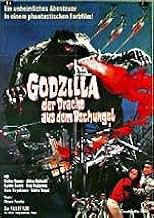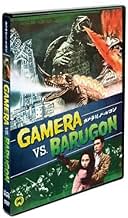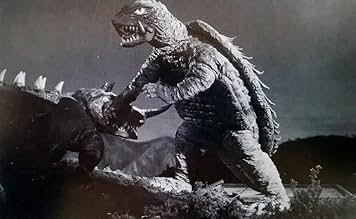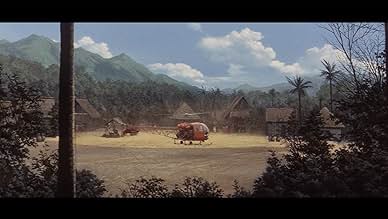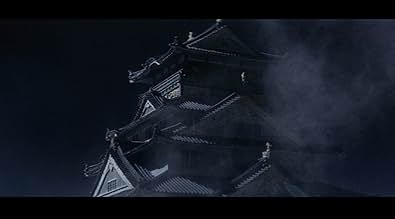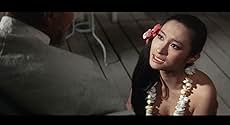IMDb रेटिंग
5.1/10
3 हज़ार
आपकी रेटिंग
अपनी भाषा में प्लॉट जोड़ेंA giant monster that emits a destructive ray from its back attacks Japan and takes on Gamera.A giant monster that emits a destructive ray from its back attacks Japan and takes on Gamera.A giant monster that emits a destructive ray from its back attacks Japan and takes on Gamera.
Jutarô Kitashiro
- Self-Defense Force Commander
- (as Jutarô Hôjô)
फ़ीचर्ड समीक्षाएं
This used to be my least favorite of the original Gamera series but I watched it recently (minus the Joel and bots comments, since I have the old MST3K episode on tape) and I was really surprised with the special effects. The opening scene where Gamera (the narrator butchers his name too) attacks the damn was well done. There are a lot of cool miniatures and as it has been mentioned several times already- this movie is 'kenny' free.
Sadly, there really isn't a lot going on in this film. I do like the overall weirdness of it all: a giant flying turtle battling against a creature who attacks people with his tongue and a rainbow! Hey, it was the 60s ... what can I say? Sady Franks either had a brainstorming session or they were high when they made these movies.
There's actually a coherent plot to this movie and I suppose Gamera changes from a baddie to a good guy in this one. They just really stretch everything so thin and there aren't enough monster fight scenes to make me happy. I'm being really generous with rating this ...
Sadly, there really isn't a lot going on in this film. I do like the overall weirdness of it all: a giant flying turtle battling against a creature who attacks people with his tongue and a rainbow! Hey, it was the 60s ... what can I say? Sady Franks either had a brainstorming session or they were high when they made these movies.
There's actually a coherent plot to this movie and I suppose Gamera changes from a baddie to a good guy in this one. They just really stretch everything so thin and there aren't enough monster fight scenes to make me happy. I'm being really generous with rating this ...
Shigeo Tanaka directed "Gamera vs. Barugon" in 1966, the second film to feature the giant fire-breathing turtle Gamera. I'll be the first to give "Gamera vs. Barugon" a fair review. This second entry into the original seven-film series is probably my favorite, simply because it doesn't feature any annoying Gamera friends; you know what I mean, kids. "Gamera vs. Barugon" is the only movie in the series to not feature annoying adolescents who can communicate with the monster. In this second feature, greedy fortune hunters head to New Guinea where they believe a priceless opal was hidden during the Second World War. Alas, they find it, but one of them is greedier than the other two and kills them both off (well, one of them is stung by a poisonous scorpion, and the other, the hero of the story, survives the attempted assassination). What the greedy man doesn't know, is that what he has in his possession is not a jewel at all, but a monster's egg, Barugon's egg. The infant monster, once exposed to infra-red heat rays, grows to its mature size and begins attacking Japan. Gamera interferes but is defeated quite easily by Barugon's freezing vapor. Meanwhile, the hero and a village girl travel back to Japan, using the ancient legends (combined with modern scientific technology) to try to defeat Barugon once and for all. When these plans fail miserably, it appears that only Gamera stands a chance of bringing Barugon's reign of terror upon Japan to an end. I'll understand this film's low rating, but believe me, as a Gamera fan (and Godzilla too), this is probably the best film in the series. Gamera is off-screen for the most part, and the new monster Barugon takes center stage laying waste to Japan. Forget the bad dubbing for once, too. The musical score is pretty exotic and atmospheric, almost comparable to anything featured in the "Godzilla" series of films. Still, for a movie that was made in '66, the effects hold up surprisingly well, even if it is easy to find the many faults with them. Believe it or not, I actually like the older kaiju films much rather than their special-effects/CGI-laden, modern-day counterparts. For these reasons, "Gamera vs. Barugon" gets a five out of 10 from me.
5/10
5/10
This is the first Gamera movie I have watched. I remembered when I was a kid I rented a VHS copy of this film. Being a kid, I was pretty weary of certain scenes in this kaiju film, like the main villain's evil tactics. This is the first Gamera movie to feature him doing battle with another monster, named Barugon. While Gamera started out as a villainous monster, Barugon proved to be an even more menacing creature, threatening to destroy everything in its path.
As a kid, I enjoyed the film, and when I wanted to rent it again, the VHS copy wasn't available anymore, so I was pretty bummed out. But, years later, this film was shown on TV and, to my delight, I have decided I have got to watch it again and remembered I was entertained by it. The plot about dueling explorers trying to get their hands on an opal from an island while the natives warn them about dire consequences that follow if they take away the gem is pretty intriguing. The special effects were serviceable but the monster battles were decent and Barugon's tongue and rainbow weapons were a pretty cool effect. The Barugon suit looked like it was made out of cardboard and the monster itself wasn't portrayed as menacing enough - I would have liked to see a little more city destruction scenes. The second half of the movie just consists of the military attempting to destroy Barugon - pretty basic, but a little thrilling nonetheless.
Overall, it's a pretty good Gamera movie that ends up being the best in the first series. It is also the only one in the original series not to feature a kid as the main character. The rest of the Gamera films were very much aimed for youngsters and are too childish and corny for my enjoyment. If you would like to see Gamera in action, check out this movie, skip the rest in the series, and catch the newer ones made in the 1990s.
Grade B-
As a kid, I enjoyed the film, and when I wanted to rent it again, the VHS copy wasn't available anymore, so I was pretty bummed out. But, years later, this film was shown on TV and, to my delight, I have decided I have got to watch it again and remembered I was entertained by it. The plot about dueling explorers trying to get their hands on an opal from an island while the natives warn them about dire consequences that follow if they take away the gem is pretty intriguing. The special effects were serviceable but the monster battles were decent and Barugon's tongue and rainbow weapons were a pretty cool effect. The Barugon suit looked like it was made out of cardboard and the monster itself wasn't portrayed as menacing enough - I would have liked to see a little more city destruction scenes. The second half of the movie just consists of the military attempting to destroy Barugon - pretty basic, but a little thrilling nonetheless.
Overall, it's a pretty good Gamera movie that ends up being the best in the first series. It is also the only one in the original series not to feature a kid as the main character. The rest of the Gamera films were very much aimed for youngsters and are too childish and corny for my enjoyment. If you would like to see Gamera in action, check out this movie, skip the rest in the series, and catch the newer ones made in the 1990s.
Grade B-
I have to agree with the first comment and say that this is the best of pre-1995 the Gamera's. I've seen five of them, Guiron and Zigra both being indescribably bad (even when I watched them as a 13 year old I thought so). This one is honestly pretty good, a step-up from the stone age-looking Gamera, which was made in 1965 but looked like it was made in 1954! First off, there isn't too much flashback footage and when it is used, it's actually well-edited and has some pretty cool narration and atmospheric music. There's a random dam attack scene which I still cant figure out why it's there, and then the real story starts with the protagonists finding a jewel that eventually turns into the secondary monster.
Gamera plays a pretty minor second-fiddle this time around, with Barugon, an admittedly more interesting monster, hogging most of the screentime destroying things. I really liked the plotting with the greedy guy accidentally waking the monster with his heat-lamp, and then getting eaten when he ruins the army's plan by trying to steal a giant diamond.
This has the best music and best scenes of destruction of any of the Gamera movies and most of Jun Fukuda's Godzilla films. While it's still Daiei, which most of the time is sub-Toho in every respect, this film shows that around 1966 Daiei actually managed to surpass Toho every now and then effects-wise. Good directing too: the tone is surprisingly mature this time around and it's got a really dark and humorless undercurrent to the whole thing.
My favorite Gamera movie, followed by the... so unintentionally hilarious, it makes me crack up thinking about it... Gamera vs. Gaos.
Gamera plays a pretty minor second-fiddle this time around, with Barugon, an admittedly more interesting monster, hogging most of the screentime destroying things. I really liked the plotting with the greedy guy accidentally waking the monster with his heat-lamp, and then getting eaten when he ruins the army's plan by trying to steal a giant diamond.
This has the best music and best scenes of destruction of any of the Gamera movies and most of Jun Fukuda's Godzilla films. While it's still Daiei, which most of the time is sub-Toho in every respect, this film shows that around 1966 Daiei actually managed to surpass Toho every now and then effects-wise. Good directing too: the tone is surprisingly mature this time around and it's got a really dark and humorless undercurrent to the whole thing.
My favorite Gamera movie, followed by the... so unintentionally hilarious, it makes me crack up thinking about it... Gamera vs. Gaos.
This was the first color sequel to the original black and white GAMERA, and it's pretty good though you have to be patient in waiting to see much of our favorite fire-breathing, flying turtle. A new monster named Barugon (not to be confused with the similarly-named creature from the Toho series of Japanese giant monster movies) is born and has the ability to freeze people and cities. The monster suits in this series were never quite up to the ones in the Godzilla films, but the effects in general are not too bad. The real fun in this one is savoring the villainous exploits of one of the main human characters... a sneaky creep named Onodera. He steals the show as one of a group of men on an expedition to New Guinea to retrieve a glowing opal believed to be worth millions. There's a fight sequence between this guy and another man who can barely walk late in the movie that's better (and much funnier) than the monsters' battle! **1/2 out of ****
क्या आपको पता है
- ट्रिवियाThis is the only film in the original series to not feature a child as the main human character.
- गूफ़English language version: If Barugon's is harmed by water, how did he swim from the sunken ship to the shore without any difficulty? The translation neglects to mention that while he's vulnerable to water, it doesn't immediately kill him, just weakens him. It has also been suggested that salt water doesn't harm him as much as fresh water.
- इसके अलावा अन्य वर्जनThe Japanese version runs a complete 101 minutes. The American International Pictures-TV (A.I.P.-TV) release version, under the title WAR OF THE MONSTERS, was cut down to 88 minutes to fit it's televised playdates. The 14 minutes that were removed were only expository scenes that had the characters discuss how to destroy the monster Barugon.
- कनेक्शनFeatured in Gamera tai uchu kaijû Bairasu (1968)
टॉप पसंद
रेटिंग देने के लिए साइन-इन करें और वैयक्तिकृत सुझावों के लिए वॉचलिस्ट करें
विवरण
- चलने की अवधि1 घंटा 46 मिनट
- ध्वनि मिश्रण
- पक्ष अनुपात
- 2.35 : 1
इस पेज में योगदान दें
किसी बदलाव का सुझाव दें या अनुपलब्ध कॉन्टेंट जोड़ें

टॉप गैप
By what name was Daikaijû kettô: Gamera tai Barugon (1966) officially released in India in English?
जवाब
